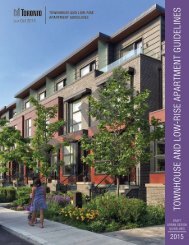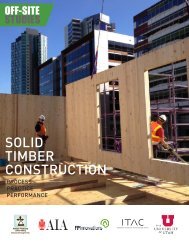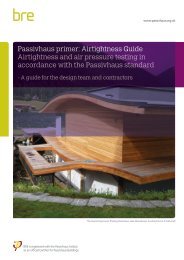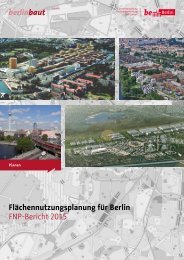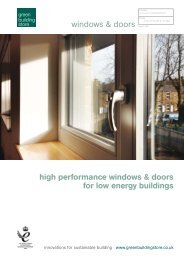TRUE URBAN SPIRIT
b008379b
b008379b
You also want an ePaper? Increase the reach of your titles
YUMPU automatically turns print PDFs into web optimized ePapers that Google loves.
4 VIENNA: NETWORKING THE CITY<br />
HIGH OPEN SPACE<br />
QUALITY IN ALL<br />
PARTS OF THE CITY<br />
Open space qualities vary from neighbourhood to neighbourhood.<br />
The inner districts with their Gründerzeit buildings offer multifaceted<br />
and interesting squares and streets, which are rare in<br />
peripheral locations and newly built quarters. Conversely, the<br />
latter boast large green and leisure zones of great attractiveness<br />
(e. g. Vienna Woods, Lobau).<br />
The availability of high-quality green and open spaces determines<br />
the quality of life. Strengthening the natural landscape character<br />
and providing sufficiently large leisure zones within walking distance<br />
are therefore key objectives of open space planning so as<br />
to offer all persons in all parts of the city places for rest, play and<br />
sport, social encounters and possibilities to experience nature.<br />
Good-neighbourly relations in the city are highly dependent on<br />
places for encounter and communication close to home. On the<br />
basis of this realisation, intensified efforts were undertaken in<br />
recent years to strengthen public space when developing new city<br />
quarters. Examples include the “Palais Kabelwerk” project in the<br />
12 th municipal district Meidling and aspern Vienna’s Urban Lakeside.<br />
Right from the beginning, the development of neighbourhood<br />
structures for aspern Vienna’s Urban Lakeside was determined<br />
by the definition of a network of streets, footpaths and squares<br />
(see Werkstattbericht No. 103 “The Score for Public Space”, the<br />
planning manual for aspern Vienna’s Urban Lakeside). The “Palais<br />
Kabelwerk” project is a good example of a place of encounter,<br />
communication and participation. Based on these initiatives and<br />
experiences, the City of Vienna will strive to improve the quality<br />
and availability of open spaces in all parts of the city, from densely<br />
built-up Gründerzeit quarters to newly developed urban zones<br />
( freespaceviennapublicspace).<br />
Vienna’s high quality of life also derives from the paucity of conflicts<br />
and a pronounced subjective feeling of safety and security in<br />
public space. In addition to planning aspects, socio-cultural projects,<br />
which as a rule are bottom-up processes and implemented<br />
by local actors (e. g. Brunnenpassage in the 16 th municipal district<br />
Ottakring), make an important contribution towards this goal.<br />
Conversely, social work in public space often plays a central role<br />
in this matter as well, as it shapes social and communicative proc -<br />
esses, accompanies, counsels and mediates in case of conflicts.<br />
Targeted community and education work as well as a broad-based<br />
dialogue strengthen and activate social cohesion and personal<br />
responsibility. Social and youth work provide on-site support and<br />
nurture the ability of clients to assume personal responsibility.<br />
These processes are to be further strengthened and networked<br />
( Mission Statement “Social Work in (Semi-)Public Space”).<br />
Thematic concept “Public Space”<br />
By evolving and detailing the Mission Statement<br />
for Vienna’s Public Space, the strategic framework<br />
of STEP 2025 serves for the development<br />
of a detailed public space concept. This thematic<br />
concept adds spatial aspects to the strategy<br />
sketched in STEP 2025 and complements it<br />
by means of implementation-oriented goals and<br />
measures.<br />
120



